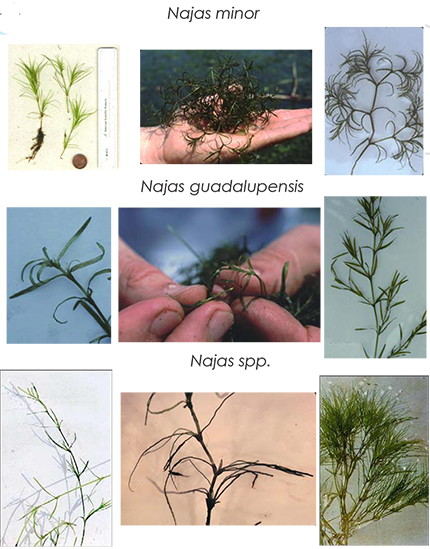Submerged Aquatic Vegetation (SAV) Identification Key
Main_Content
The bay grass key was designed to allow you to identify most species of bay grasses found in Maryland. Although bay grasses are notoriously difficult to identify using standard taxonomic keys, the flexible format of the Internet allows us to combine detailed pictures, simple line drawings and text messages in a stepwise sequence that makes identifying bay grasses simple. You may find it useful to have a clear metric ruler with millimeters marked, a magnifying glass, and a Ziploc plastic bag to help you in the process of identifying your plant.

|
If you already know the identity of a particular bay grass use the drop down boxes below. |
|---|
Common Name:
or
Scientific Name:
| | Common Name: | Naiads |
| | Scientific Name: | Najas spp. |
| | Native or Non-native: | Native, except for N. minor which is Non-native
|
| | Illustration: | 
|
| | Link to larger illustration: | |
| | Printable Version: | |
| | Family: | Najadaceae |
| | Distribution: |
Four naiad species occur in Chesapeake Bay. The first two are more common than the latter two.
- Najas guadalupensis (southern naiad or bushy pondweed)
- Najas minor (spiny naiad)
- Najas flexilis (northern naiad)
- Najas gracillima (slender naiad)
Naiads are native except for N. minor which was introduced from Europe. Naiads grow primarily in lakes and freshwater portions of Chesapeake Bay tributaries. Bushy pondweed tolerates slightly brackish water. Naiads can tolerate a wide variety of substrates and tolerate relatively low light.
|
| | Recognition: |
Naiads vary in size from inch-high tufts on sandy bottoms to highly branched plants two or three feet high on silty bottoms. In general the naiads have slender, branching stems with narrow leaves that broaden at the base and are opposite or in whorls. Naiads have small, fibrous roots without rhizomes or tubers. The four species in Chesapeake Bay resemble one another, however, their leaves provide distinguishing characteristics. Bushy pondweed and northern naiad have wider leaves than the other two species. Bushy pondweed leaves are flat and straight, whereas leaves of northern naiad curve out from the stem at maturity. Slender naiad and N. minor have slender leaves with a truncated (abruptly-ending) basal sheath. N. minor is distinguished from slender naiad by stiff, recurved leaves and lengthwise ribs on its seed coat. Slender naiad has minute leaf-margin teeth that are difficult to see, whereas leaf-margin teeth of N. minor are visible to the naked eye. |
| | Ecological Significance: | N. guadalupensis and N. flexilis are considered to be excellent food sources for waterfowl. All parts of the plants (stems, leaves and seeds) are eaten by a variety of waterfowl including lesser scaup, mallards and pintails. The other two species of Naiads are less important due to their scarcity (N. gracillima) and low nutritional value (N. minor).
|
| | Similar Species: | Naiad species are similar in appearance and misidentifications are common even for experts unless plants are fully developed. All except for N.minor are difficult to distinguish without the use of a handheld lens and some experience. |
| | Reproduction: | Reproduction occurs primarily by seed in late summer. Male and female flowers are located on leaf axils. Seed germination and plant growth occur in late spring. The seeds that develop after pollination have surface markings, and each species has its own characteristic markings.
|
|
|
Center_Content
For permission to reproduce individual photos, please contact Mike Naylor
The text and photos used in this key were produced through a collaborative effort among the following partners.

